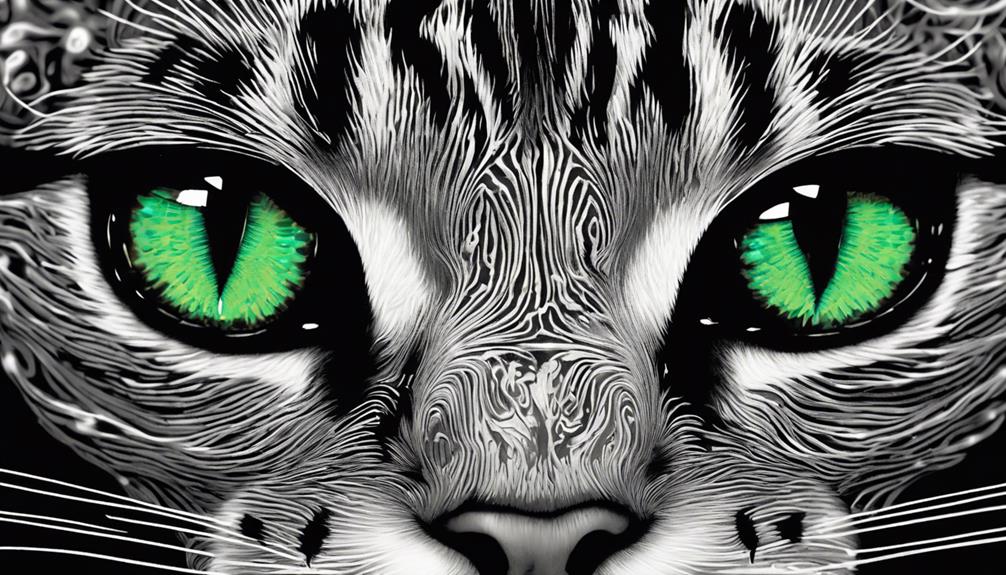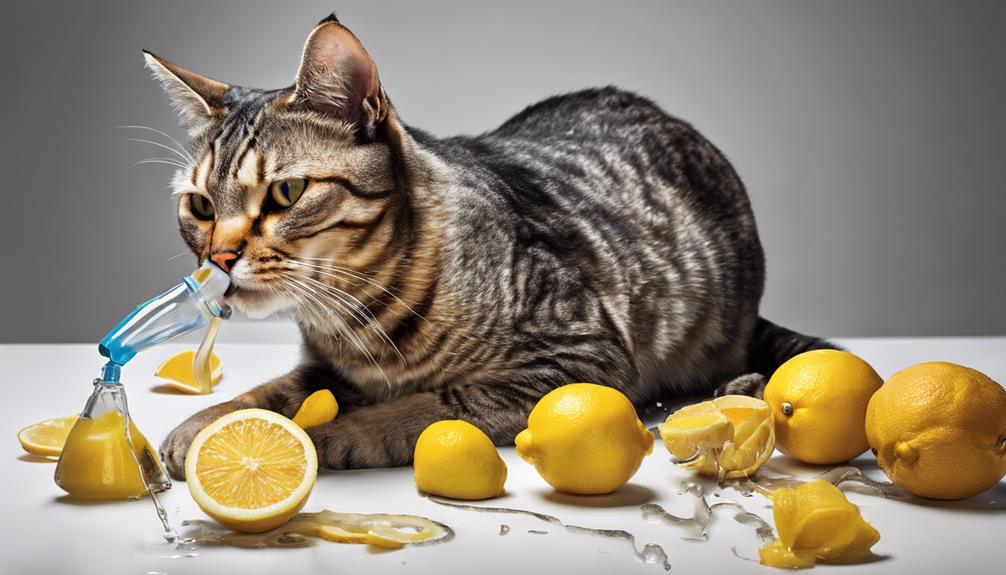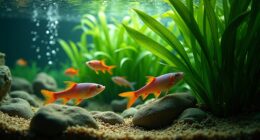Cats' exceptional night vision is a result of specialized anatomy and unique adaptations that help them thrive in low-light settings. Their eyes are equipped with high numbers of rod photoreceptors essential for dim-light vision. The tapetum lucidum, a reflective layer, enhances their ability to see in the dark. Cats' slit-shaped pupils dilate to allow more light in, aiding in hunting during the night. Their prowess in low-light conditions and nocturnal activities showcase their remarkable vision adaptations. Exploring cats' night vision further can reveal fascinating insights into their hunting strategies and survival skills.
Key Takeaways
- Cats' night vision abilities are inherent from a young age.
- Kittens develop night vision gradually within their first few weeks.
- Tapetum lucidum and rod cells support kittens' night vision.
- Cats' night vision matures as they grow, improving with age.
- Older cats retain sharp night vision due to their specialized eye anatomy.
Cats Exceptional Night Vision
In the domain of nocturnal prowess, cats reign supreme with their exceptional night vision capabilities. When the sun dips below the horizon and the world is cloaked in darkness, cats' eyes come alive, ready to navigate the shadows with precision. Their ability to see in low light is a marvel of nature, thanks to their specialized anatomy. The large corneas, tapetum lucidum, and high number of rod photoreceptors all play important roles in enhancing their vision in dimly lit environments.
One of the key factors contributing to cats' exceptional night vision is their slit-shaped pupils. These pupils dilate widely in the dark, allowing more light to enter the eye and reach the retina. This adaptation improves their ability to see in low light conditions, giving them a distinct advantage when hunting during twilight hours. With their superior night vision, cats become formidable predators in the cover of darkness, relying on their keen eyesight to stalk their prey with unparalleled efficiency.
Rod Photoreceptors in Cats Eyes
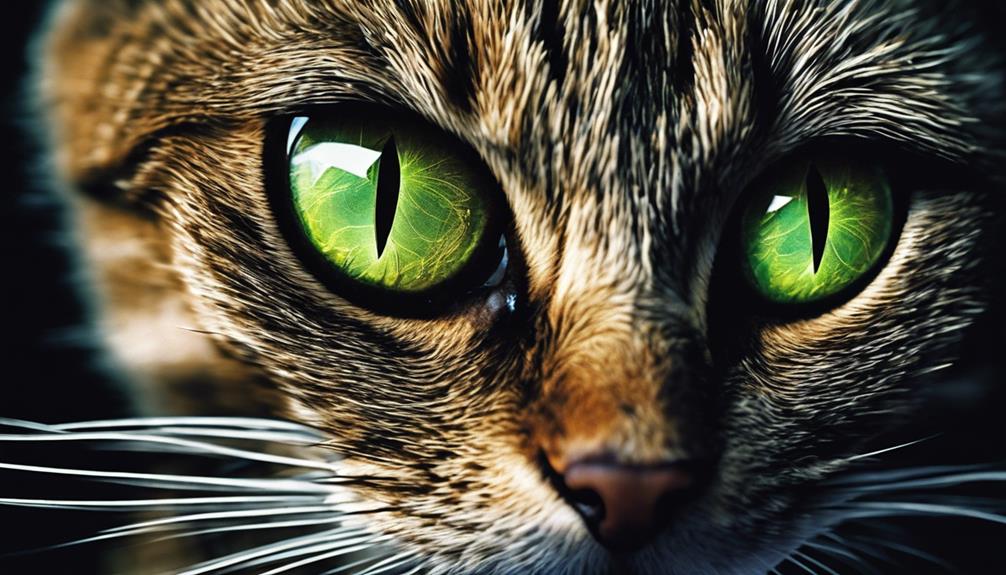
Cats' eyes are equipped with a higher concentration of rod photoreceptors, specialized cells important for low-light vision.
These rod cells play a key role in the feline night vision mechanism, allowing them to navigate and hunt effectively in dimly lit environments.
The abundance of rod photoreceptors in cats' eyes contributes greatly to their exceptional ability to see in the dark.
Rod Cells Function
Detecting light in low-light conditions is the primary function of rod cells in the eyes of cats. These specialized cells play a critical role in enabling our feline friends to navigate and hunt effectively during the night.
With a higher concentration of rod photoreceptors in their retinas than humans, cats possess superior night vision capabilities. The abundance of rod cells allows cats to perceive movement and shapes clearly in dim lighting, giving them an edge as efficient hunters after dark.
Their eyes' sensitivity to light, thanks to these rod cells, contributes immensely to their prowess in the dark. It's fascinating how these tiny cells work together to enhance our cats' ability to see in low-light conditions, making them skilled nocturnal predators.
Night Vision Mechanism
With a remarkable abundance of rod photoreceptors in their eyes, cats possess superior night vision capabilities that enable them to navigate and hunt effectively in low-light conditions.
These rod photoreceptors play a pivotal role in the night vision mechanism of cats, allowing them to excel in dim light environments where human vision would falter.
The high concentration of rod cells in their retinas grants cats the ability to detect even the slightest movements of their prey under the cover of darkness.
This adaptation makes cats formidable hunters during the night, giving them an edge in spotting potential meals and avoiding obstacles in the dark.
Their exceptional night vision is a product of evolution, finely tuned to suit their nocturnal hunting habits and ensuring their survival in various environments.
Tapetum Lucidum: Cats Vision Enhancer
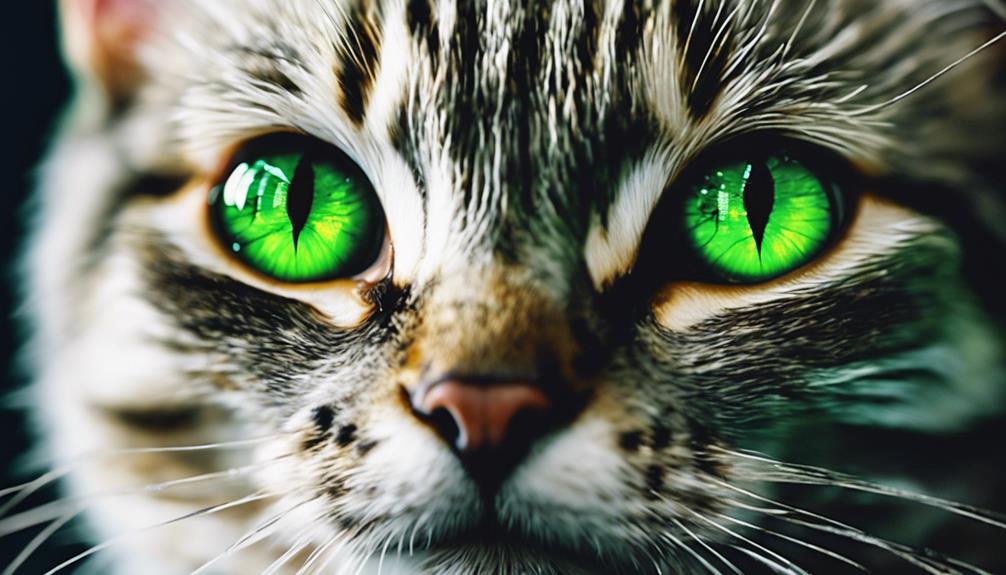
Enhancing cats' night vision, the tapetum lucidum is a reflective layer located behind their retinas. This unique feature acts like a mirror, bouncing light back through the eye to enhance vision in low light conditions. Ever noticed that mesmerizing glow in your cat's eyes in the dark? That's the 'eye shine' effect caused by the tapetum lucidum. It's like a built-in flashlight that helps them navigate the night with ease.
The tapetum lucidum is a game-changer for our feline friends, especially during their crepuscular hunting escapades at dawn and dusk. This adaptation sets them apart, giving them an edge with superior night vision compared to us humans and other animals. Thanks to this layer, cats can spot their prey or playmates in the dimmest of light, making them stealthy ninjas of the night.
Next time you catch your kitty's eyes gleaming in the darkness, remember it's all thanks to their amazing tapetum lucidum – the secret behind their nocturnal prowess.
Cats Dilating Slit-Shaped Pupils
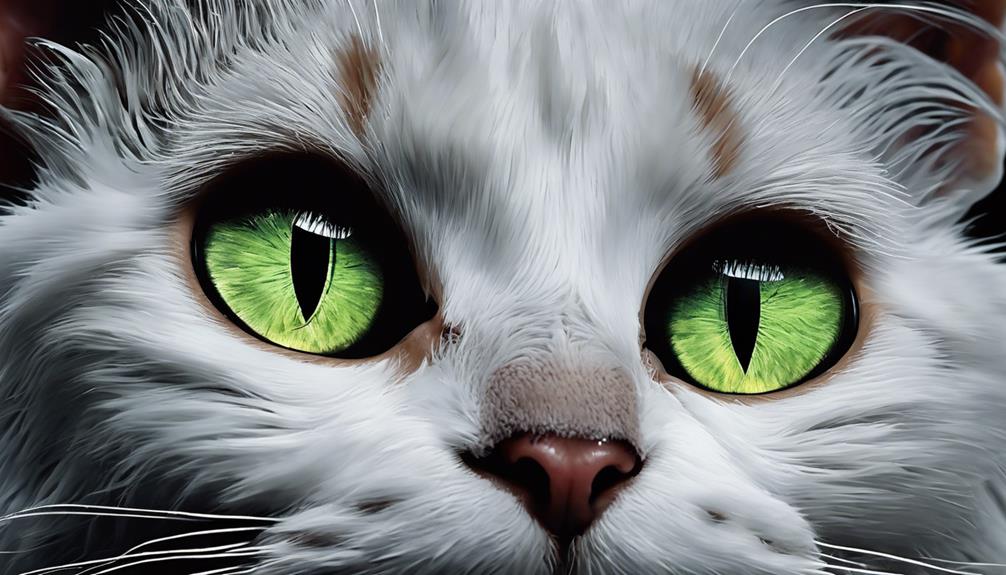
Cats' slit-shaped pupils are like nature's built-in camera lenses, adjusting to light levels with remarkable precision.
When the sun sets and darkness descends, these pupils dilate to let in as much light as possible, enhancing the cat's night vision capabilities.
This mechanism not only aids in their ability to see in the dark but also contributes to their overall visual acuity in various lighting conditions.
Pupil Dilation Mechanism
Our feline friends' unique slit-shaped pupils, dilating up to 135 times more than humans', play an essential role in their exceptional night vision abilities. Cats' pupils adjust swiftly to low light conditions, allowing them to see clearly in the dark. This remarkable pupil dilation mechanism is a vital adaptation that enhances their vision in dimly lit environments.
When the sun sets and darkness envelops the surroundings, cats rely on their pupils to expand, maximizing the amount of light entering their eyes. This dilation process is an evolutionary advantage that enables cats to navigate the night with precision and confidence. Through their specialized pupils, cats possess a remarkable ability to adapt to varying light levels, showcasing their unparalleled night vision prowess.
Light Adaptation Process
In low light conditions, cats' slit-shaped pupils swiftly dilate to optimize light intake for enhanced night vision capabilities. Cats see the world through a unique lens, adapting quickly to the darkness by allowing more light to flood their eyes.
This remarkable ability to expand their pupils efficiently is a vital part of their night vision prowess. In the dim light of the night, cats' pupils expand greatly, ensuring they can navigate their surroundings with precision and clarity.
The light adaptation process in cats is truly fascinating, enabling them to see effectively even when the world around them is shrouded in darkness. Witnessing a cat's eyes adjust to the night is a demonstration of their remarkable visual acuity in low light settings.
Enhanced Visual Acuity
Dilating their slit-shaped pupils, cats optimize their night vision capabilities by allowing more light to enter their eyes in low light conditions. This unique feature enables cats to adjust swiftly to the darkness, enhancing their visual acuity when prowling in dimly lit environments.
The slit-shaped pupils act as nature's own night vision goggles, helping cats navigate with precision through shadows and darkness. By dilating their pupils, cats can capture as much available light as possible, granting them a significant advantage in hunting and exploring during nighttime hours.
These remarkable slit-shaped pupils showcase the ingenious adaptations that make cats such adept nocturnal hunters, allowing them to see clearly where human eyes would struggle.
Cats Vision in Low-Light Conditions
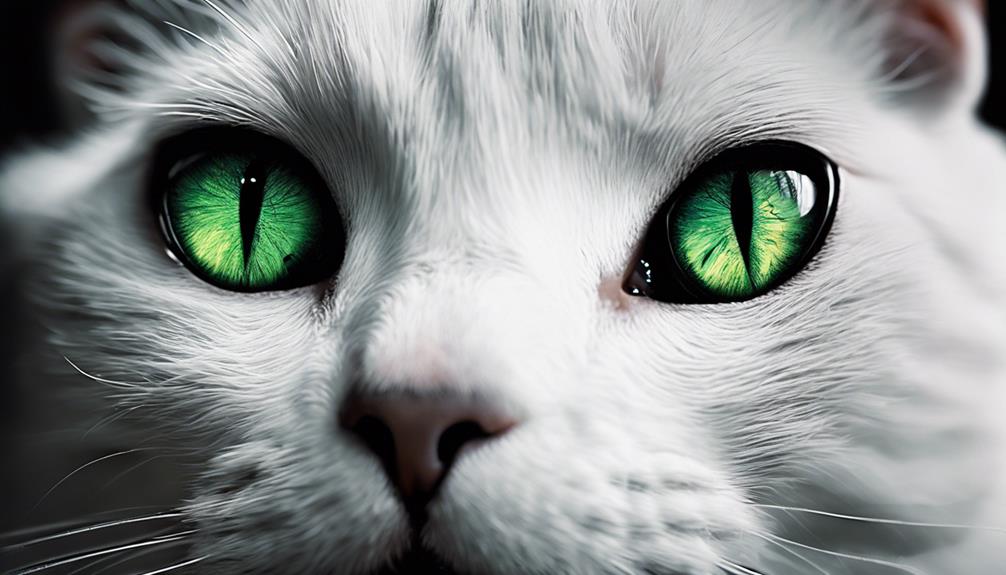
With their specialized eyes, cats excel in low-light conditions due to an abundance of rod photoreceptors and a reflective layer called the tapetum lucidum. This unique combination allows them to see in the dark much better than we can.
Imagine if we'd built-in night vision goggles like cats do! Their increased number of rods and the tapetum lucidum not only help them navigate in dimly lit environments but also give them an edge when hunting during twilight hours. Cats' eyes are truly remarkable in adapting to low-light conditions.
Their slit-shaped pupils dilate to let in more light, providing them with enhanced vision even in the darkest of settings. Compared to humans, cats require far less light to see effectively, making them superb nocturnal hunters. It's fascinating how nature has equipped these feline creatures with such incredible visual abilities, allowing them to thrive in the shadows like skilled predators.
Cats Nocturnal Hunting Abilities

At twilight, cats showcase their exceptional hunting prowess, utilizing their specialized eyes and heightened nocturnal instincts to stalk prey with remarkable precision. Cats' unique ability to see in the dark sets them apart as nocturnal hunters. With their eyes adapted to low light conditions and an abundance of rod photoreceptors, cats excel in hunting during the night. Their vision is finely tuned to detect even the slightest movements, allowing them to swiftly capture prey under the cover of darkness.
To better understand how cats' night vision aids in their hunting abilities, let's explore the following table:
| Night Hunting Abilities | Description |
|---|---|
| Specialized Eyes | Cats possess more rod photoreceptors for improved vision in low light. |
| Nocturnal Instincts | Cats rely on their heightened senses to navigate and hunt effectively at night. |
| Stealthy Stalkers | Cats' ability to see in the dark enables them to stalk prey silently and with precision. |
Cats are truly masters of the night, utilizing their exceptional vision and instincts to thrive in the darkness and secure their prey.
Maximum Light Intake in Cats
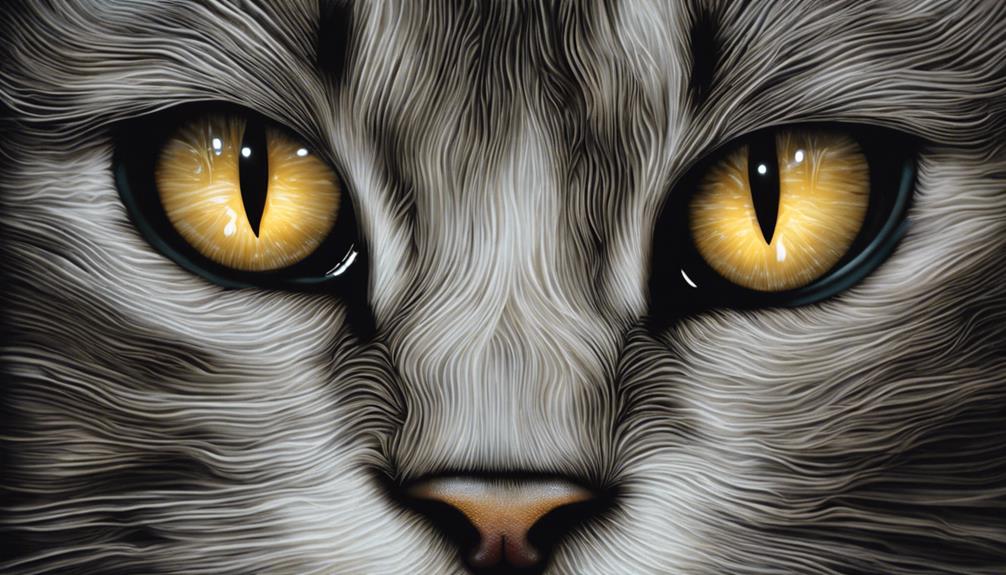
Cats optimize their vision in low light conditions through mechanisms such as large corneas and pupils that allow for maximum light intake. The tapetum lucidum, a reflective layer behind the retina, boosts their night vision by bouncing light back into the eye. This unique feature makes their eyes appear to glow in the dark, enhancing their ability to see in dim light environments.
Additionally, cats' pupils dilate widely in the dark, letting more light enter the eye and further improving their vision at night. Their eyes are equipped with a higher number of rod photoreceptors compared to humans, specialized cells that excel in detecting low light levels. This abundance of rods means that cats require less light than humans to see effectively, giving them a significant advantage in hunting and moving in the dark.
With these remarkable adaptations, cats truly excel as nocturnal hunters, utilizing their exceptional vision to thrive in the darkness.
Cats Vision Vs. Humans
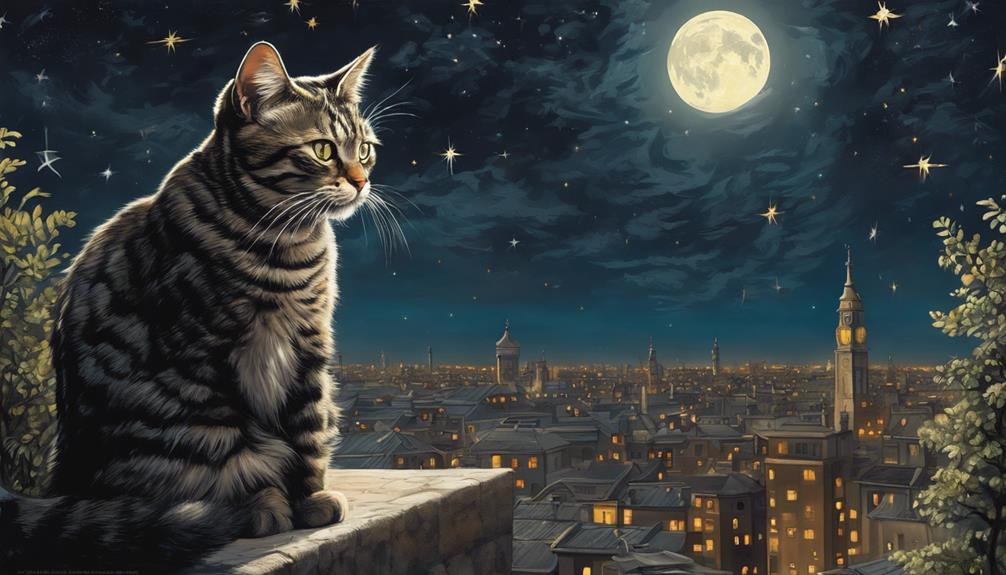
Cats have a unique advantage over humans when it comes to vision in low-light conditions. Their vertically slit pupils allow for a 135-fold increase in light intensity adjustment, far surpassing the capabilities of human eyes.
While humans may have better visual acuity overall, cats excel in seeing in the dark due to their specialized eye structure.
Cat Vs. Human Vision
When comparing cat vision to human vision, it becomes evident that there are significant differences in how each species perceives the world visually.
- Cats' eyes have vertically slit pupils, allowing them to control the amount of light entering their eyes more effectively than humans.
- Cats excel in low light conditions due to their ability to adjust light intensity on their retinas 135 times more than humans.
- Humans may have better visual acuity than cats, but felines have the upper hand when it comes to responding to light in the dark.
- Cats see mostly in shades of gray, which aids them in traversing and hunting in the dark more efficiently.
Understanding these distinctions sheds light on the unique visual capabilities of cats versus humans.
Night Vision Abilities
In the domain of night vision abilities, felines and humans exhibit distinct differences in their visual acuity in low-light conditions. Cats, with their abundance of rod photoreceptors, possess a remarkable advantage when it comes to seeing in the dark. Their tapetum lucidum, a reflective layer in the eyes, boosts their night vision by bouncing light back to the retina. Additionally, those alluring slit-shaped pupils of theirs dilate generously to allow more light into their eyes, giving them an edge in the dimness of night.
While cats excel in low-light conditions, they do struggle in total darkness as they still need some light for the best vision. It's fascinating how these small feline creatures navigate the night world with such precision and grace.
Cats Night Vision Evolution
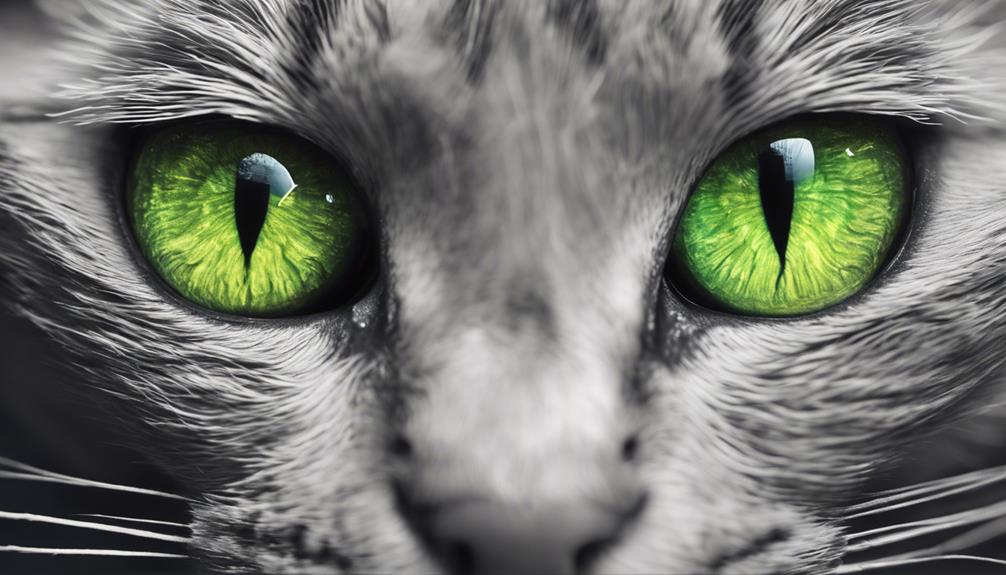
Through centuries of adaptation, slit pupils have been an important evolutionary trait for ambush predators like cats. Cats' ancestors, solitary hunters in the dark, relied on their exceptional night vision to secure their next meal. As the feline species evolved, their vertical pupils became a defining feature, aiding in depth perception vital for hunting success. Here are four key points to ponder about cats' night vision evolution:
- The slit pupils in cats allow them to control the amount of light entering their eyes, enhancing their visual acuity in dim light conditions.
- Cats' unique eye structure enables them to estimate distances accurately, giving them an advantage when stalking prey in the dark.
- Over generations, cats have honed their night vision capabilities, making them formidable hunters even in low-light environments.
- The evolution of cats' night vision has shaped them into efficient predators, perfectly adapted to thrive in the shadows of the night.
Cats Near-Sightedness
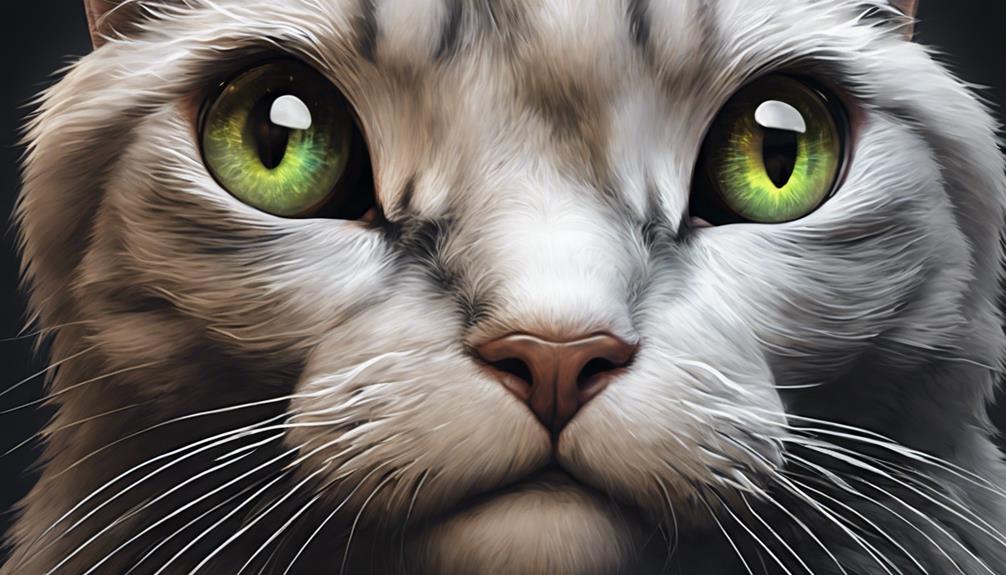
As we explore cats' remarkable visual adaptations, it becomes evident that their near-sightedness is a significant aspect to ponder in understanding their sensory capabilities. Unlike human eyes that can adjust focus easily between near and far objects, cats struggle with seeing things at a distance. This near-sightedness is due to the shape and structure of their eyes, which are optimized for hunting and moving in low light rather than for long-distance vision like human eyes.
Cats compensate for this limitation by relying more on their heightened senses of smell and hearing to detect and recognize objects that are far away. When interacting with our feline friends, it's crucial to keep in mind their near-sightedness, ensuring that they feel comfortable and safe in their environment.
How Cats Navigate in the Dark
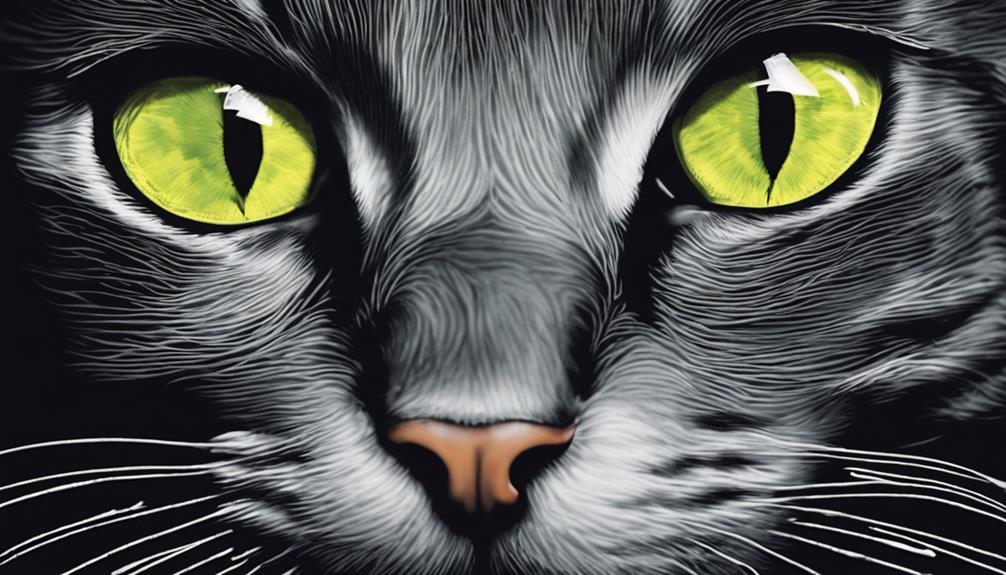
Utilizing their enhanced night vision and specialized eye structures, cats adeptly navigate through darkness with remarkable precision and ease. In low light conditions, cats' large corneas, slit-shaped pupils, and reflective layer known as the tapetum lucidum work together harmoniously to grant them superior night vision capabilities. The tapetum lucidum reflects incoming light back to the retina, amplifying their vision in the dark, almost like having a built-in night vision filter. Cats' ability to dilate their pupils allows them to adjust swiftly to varying light levels, ensuring they can traverse dimly lit environments with confidence and grace.
- Picture a cat effortlessly gliding through the shadows, every step deliberate and calculated.
- Imagine the tapetum lucidum in action, turning sparse moonlight into a guiding beacon for the feline explorer.
- Consider the slit-like pupils of a cat, expanding and contracting like tiny gateways to the nocturnal world.
- Envision a cat's eyes as windows to a domain where darkness isn't an obstacle but an ally in its nightly adventures.
Cats Nocturnal Prowess
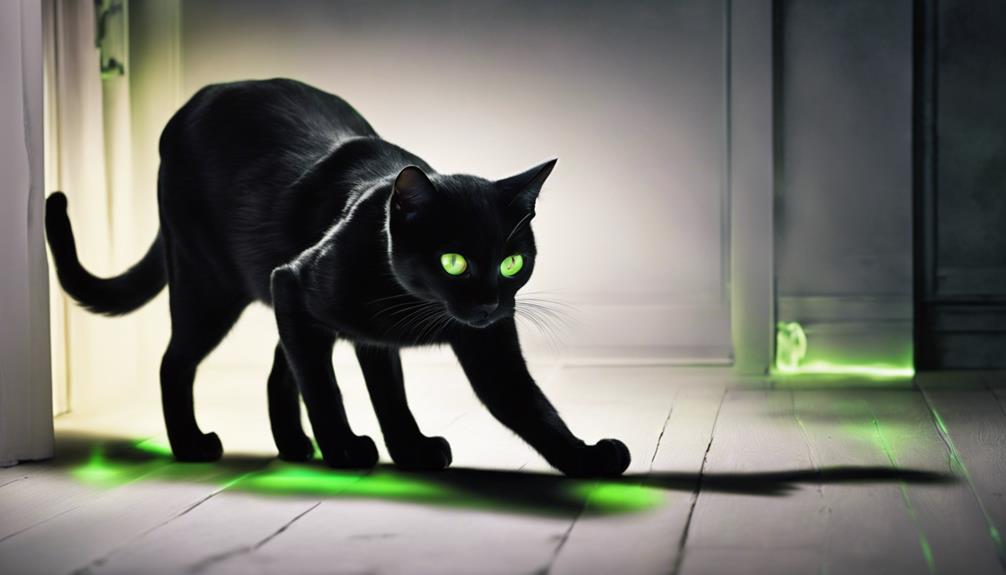
Cats, while not strictly nocturnal, showcase remarkable prowess during dawn and dusk, leveraging their exceptional night vision for the best hunting and exploration. Their eyes are equipped with a higher number of rod cells, allowing them to see in low light conditions better than humans. The tapetum lucidum, a reflective layer in their eyes, further enhances their night vision by reflecting light back through the retina. This unique adaptation gives cats the ability to detect movement and navigate their surroundings effectively during twilight hours.
One fascinating feature of a cat's eyes is their slit-shaped pupils. These pupils can dilate widely in the dark, allowing more light to enter the eye and improving vision in dim lighting. This adaptation gives cats an edge when hunting at dusk or dawn, as they can easily spot prey even in low light conditions. By being crepuscular animals, cats have evolved to maximize their night vision capabilities, making them skilled predators during the twilight hours.
Cats Night Vision Adaptations
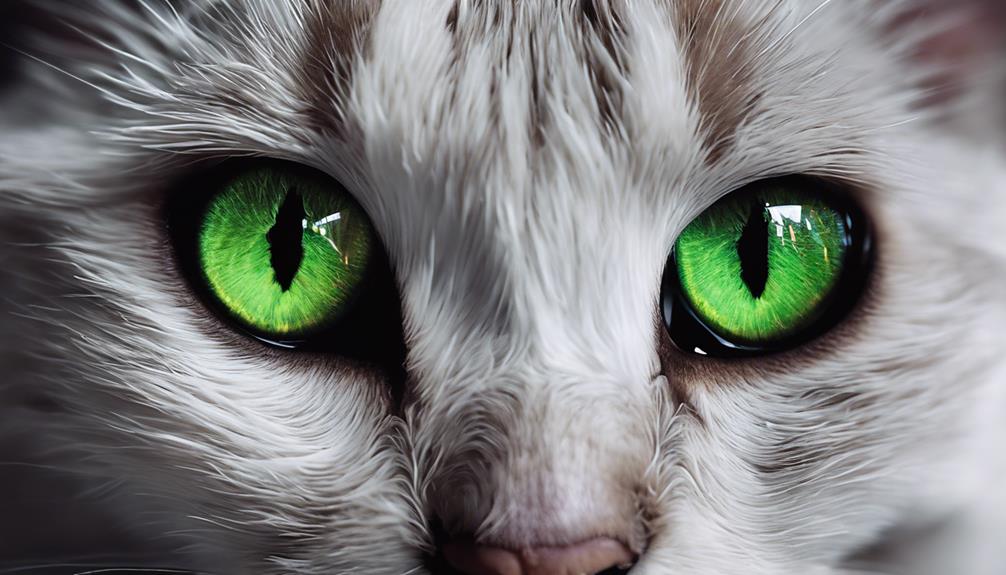
Our feline companions' exceptional night vision adaptations equip them with a remarkable advantage in low light conditions. These adaptations enable them to see in total darkness and hunt with precision under the dimmest moonlit skies.
The levels of light that our cats can perceive far surpass our own, revealing a world of shadows and movements we could never fathom. Their night vision adaptations, such as the tapetum lucidum and slit-shaped pupils, create a fascinating spectacle of nature's ingenuity in enhancing their visual acuity.
The abundance of rod photoreceptors in their eyes grants them the gift of clarity in the darkest of nights, painting a picture of a world illuminated by their unique perspective. Witnessing a cat navigate effortlessly through the night serves as a gentle reminder of the beauty and complexity of the natural world, where even the dimmest light holds secrets waiting to be disclosed.
Understanding Cats Night Vision
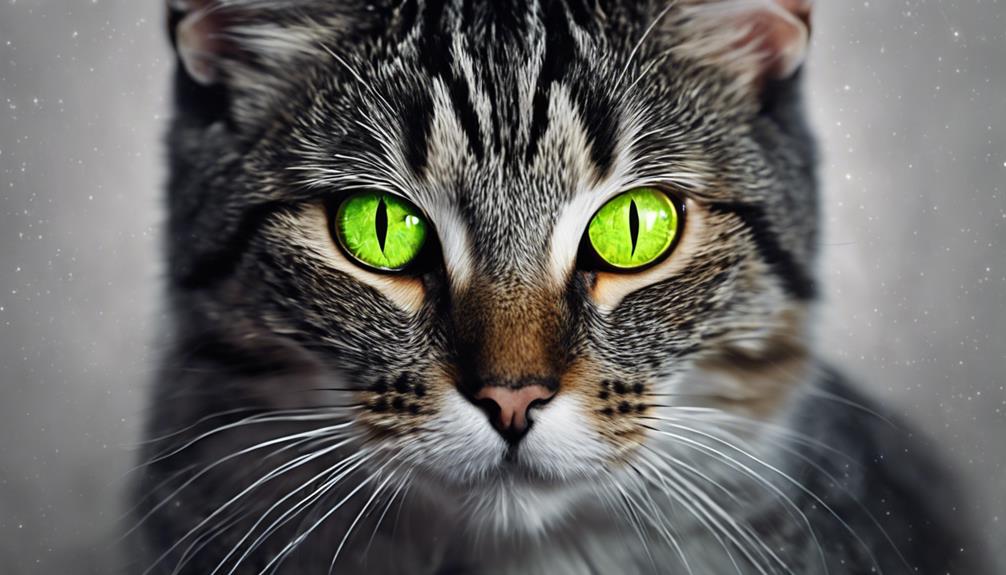
In delving into the intricacies of feline physiology, one cannot overlook the remarkable phenomenon of cats' night vision capabilities. Cats possess a unique set of adaptations that make them masters of the night. Their eyes are equipped with a high number of rod photoreceptors, specialized cells that excel in low-light conditions. Additionally, cats have a structure called the tapetum lucidum, a reflective layer behind the retina that bounces incoming light back, giving it a second chance to be detected by the photoreceptors, thereby enhancing their night vision ability.
Let's take a closer look at how these features contribute to cats' exceptional night vision in the table below:
| Night Vision Feature | Function |
|---|---|
| Rod Photoreceptors | Specialized cells that excel in low-light conditions |
| Tapetum Lucidum | Reflects light to enhance night vision capabilities |
With their slit-shaped pupils dilating widely in the dark, cats can effectively navigate and hunt in low-light environments. This heightened sensitivity to light allows them to see in conditions where humans would struggle.
The Science Behind Cats Night Vision
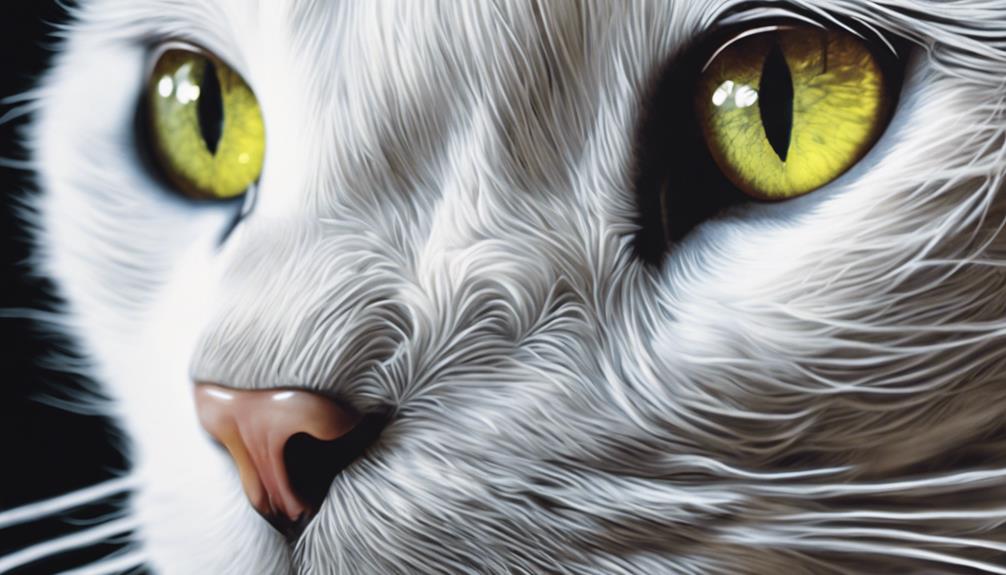
Exploring the intricate mechanisms of feline vision reveals the fascinating science behind cats' exceptional night vision capabilities. Cats possess remarkable adaptations that allow them to see in very low light conditions, making them adept hunters during the night. Here are some key aspects of the science behind cats' night vision:
- Rod Photoreceptors: Cats have a higher density of rod photoreceptors in their retinas compared to humans. These specialized cells are vital for detecting light in dim environments, providing cats with enhanced vision in the dark.
- Large Pupils: The large pupils of cats can dilate significantly in low light, allowing more light to enter their eyes. This adaptation maximizes their ability to capture available light for improved visibility during nighttime activities.
- Tapetum Layer: The tapetum layer located behind cats' retinas reflects incoming light back through the retina, giving the photoreceptors a second chance to detect it. This reflective layer enhances cats' ability to see in the dark.
- Widening Pupils: Cats' slit-shaped pupils widen at night to allow for maximum light intake, further optimizing their night vision capabilities. This adjustment helps them navigate and hunt efficiently in the darkness.
Frequently Asked Questions
Can My Old Cat See in the Dark?
We notice our old cat's night vision might diminish with age. Regular vet check-ups are vital. Our cat may rely more on hearing and smell. Providing a well-lit environment helps them feel secure at night.
Can Cats See in Total Darkness?
We can't see in total darkness, and neither can cats. They need some light to see. In low light environments, cats excel, but pitch-black darkness is a challenge for their vision. Their eyes are built for less light, not none.
Is It Harder for Cats to See in the Dark?
In the dark, we see with ease. Cats find it simpler too. Their eyes, designed for dimness, aid them. More rods, bigger pupils – all make seeing at night a breeze for our feline friends.
Does My Cat Think I Can See in the Dark?
We can't blame our cat for thinking we see in the dark like them. They don't realize our limitations. They rely on their night vision, making it hard to understand we need extra light. It's a cute misunderstanding.
Conclusion
To sum up, cats' night vision is truly remarkable, allowing them to navigate the darkness with ease. Their unique adaptations, such as rod photoreceptors and tapetum lucidum, give them an advantage in low-light conditions.
With their dilating slit-shaped pupils and nocturnal prowess, cats are truly masters of the night. Understanding the science behind their exceptional vision sheds light on their incredible abilities, making them fascinating creatures to observe in the darkness.
